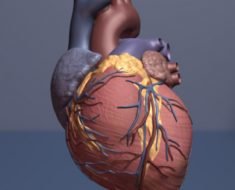Heart failure is classified according to its cause, its severity and its features. Heart failure may be categorized in various different ways, ranging from how the symptoms started through to the type of muscle abnormality that is occurring.
Categorization according to the side of the heart involved
Heart failure may be categorized according to which side of the heart is affected. Such categories include:
- Left-sided failure or forward failure that leads to congestion in the lungs
- Backward failure or right sided failure leading to excess fluid accumulation in the body
- Failure of both sides or biventricular failure
Muscle abnormality
The heart failure may arise from the abnormal contraction or relaxation of the heart muscles. For example, systolic heart failure or systolic dysfunction describes when the heart is unable to pump out blood during systolic contraction.
Diastolic heart failure or diastolic dysfunction describes when the heart is unable to dilate enough between two contractions to gather an adequate amount of blood that can be pumped out during systole.
Output dysfunction
The heart failure may be categorized according to the type of dysfunctional output.
High-output heart failure occurs when the heart is functioning normally but cannot meet the increased demands of the body for blood flow to certain organs. This can occur as a result of anemia, when oxygen content in the blood is low and the heart needs to pump more to meet the demands for oxygen. Another cause is Paget's disease where abnormal bone growth has resulted in the formation of new blood vessels which require extra blood supply.
Low-output failure occurs when the cardiac output is insufficient to perfuse the body leading to impaired circulation of the peripheries, for example, or vasoconstriction giving rise to high blood pressure.
Heart failure onset
- Acute heart failure refers to the acute or sudden onset of heart failure.
- Chronic heart failure is progressive heart failure that worsens gradually, over time.
Functional classification
Heart failure may also be categorized according to how the heart is functioning and how severe the symptoms are.
The New York Heart Association Functional Classification includes 4 classes of heart failure:
Class I – No symptoms when performing daily activities
Class II – Heart activity is only mildly limited, with little or no symptoms on mild exertion.
Class III – The patient is comfortable when they are resting, with symptoms only triggered on mild exertion
Class IV – Symptoms may occur when a patient is resting
Sources
- http://www.nhs.uk/Conditions/Heart-failure/Pages/Introduction.aspx
- http://www.heartfailureguideline.org/_assets/document/Guidelines.pdf
- http://www.sign.ac.uk/pdf/sign95.pdf
- www.heart.org/…/ucm_300315.pdf
- https://www.ghc.org/all-sites/guidelines/heart-failure.pdf
- www.nlm.nih.gov/…/ct129106.pdf
Further Reading
- All Heart Failure Content
- Heart Failure
- Heart Failure Terminology
- Heart Failure Symptoms
- Heart Failure Causes
Last Updated: Feb 26, 2019

Written by
Dr. Ananya Mandal
Dr. Ananya Mandal is a doctor by profession, lecturer by vocation and a medical writer by passion. She specialized in Clinical Pharmacology after her bachelor's (MBBS). For her, health communication is not just writing complicated reviews for professionals but making medical knowledge understandable and available to the general public as well.
Source: Read Full Article





